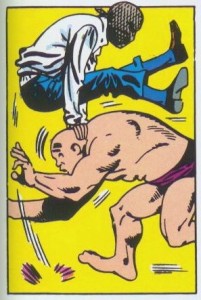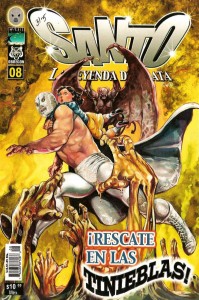Real Life Superheroes: Comic Books and Pro Wrestling by Jerry Whitworth
Some of the earliest fighting systems created by mankind were boxing and wrestling. While intended for use on the battlefield, these forms would also become competitive sports as evident in the Olympic games of ancient Greece. Mythological heroes of this time period would include the Argonauts, such as the Gemini. Brothers Castor and Polydeuces/Pollux, the Dioscuri (better known today as the Gemini) were reportedly two of history’s greatest wrestlers. However, according to Greek myth, the greatest wrestler (and also an Argonaut) was Heracles, arguably the greatest mythological hero in human history. Heracles would represent the most prevalent archetype for heroes in our history in the strongman, such heroes that have existed in this vein include Gilgamesh, Thor, Beowulf, Hercules, Hanuman, Sha Wujing, Raijin, Samson, Superman, and Captain Marvel. It’s little wonder piecing all of this information together of the similarities shared today by comic books and professional wrestling. In essence, both derive from mythology. For pro wrestling, it’s some amalgamation of wrestling competition and hero plays (another ancient Greek tradition). For comic books, it’s the modern storytelling of heroes, performing great feats of bravery while combating the nigh-unimaginable threats that plague humanity. Therefore, it should be of little wonder how these elements have intermingled through the years since their mutual advents.
While challenging to establish a viable timeline describing at what point the two forms of media converged, an early example interestingly enough is with Superman. Often credited as the first superhero, Superman was published by National Allied Publications in 1938 where he proved to be a great success with the emerging audience for comic books. Following this, Fleischer Studios was tasked with adapting the character for a series of animated shorts that premiered in 1941 (which National invested a great deal of money into because of the quality of product Fleischer was known for creating). When the time came to transfer the static, two-dimensional figure of Superman to a dynamic, three-dimensional figure rendered for animation, animators employed a real life model for the Man of Steel. Their choice was none other than future professional wrestler Karol Krauser. While this career path came some years after modeling for Fleischer, Krauser would go on to join three other wrestlers to form the Kalmikoffs, a fictitious stable of Russian brothers. The Superman comics themselves would infrequently involve itself in the world of professional wrestling such as in Superman’s Girlfriend, Lois Lane #8 (April 1959) where Lois must deal with a wrestler suitor in the so-called Ugly Superman and Superman #155 (August 1962) where Superman must battle real life wrestler Antonino Rocca who was supposedly empowered by Mister Mxyzptlk. The same month Superman battled Rocca, another wrestler would play a critical role in the origin of another world famous superhero.
In the pages of Amazing Fantasy #15 (August 1962), Peter Parker is empowered after being bitten by a radioactive spider and uses these newfound abilities to try and earn money. His earliest bid was in battling Crusher Hogan, the star wrestler of his league who offered a cash prize to those that could last three minutes in the ring with him. Parker, who Hogan dubbed “a little Masked Marvel,” easily defeated the wrestler which lead to Parker being discovered by a television producer and some time later his fateful encounter with the unnamed Burglar at a television studio he failed to stop that murdered his Uncle Ben (leading to becoming the hero Spider-Man). Marvel Comics would also infrequently dabble in the world of professional wrestling as time passed. Spider-Man would again battle another wrestler in Amazing Spider-Man #139 (December 1974), this time one empowered by one of his greatest enemies in the Jackal who gives disgruntled wrestler Maxwell Markham an exoskeleton to become the Grizzly in order to enact revenge on J. Jonah Jameson for costing him his job. In Thor #290 (December 1979), the Norse god becomes embroiled in a feud between wrestlers El Vampiro and El Toro Rojo, secretly an Eternal and a Deviant respectively. The latter would return to align with the Avengers in 1994 as part of the Delta Force. The same year Thor would tussle with El Toro Rojo, a group of female wrestling supervillains that would infrequently battle Earth’s heroes emerged in Marvel Two-in-One #54. Originally a group involved with the Femizon time traveler Thundra, one of the Grapplers’ members in Screaming Mimi would go on to trouble the Avengers (before later becoming their ally). In 1985, Marvel comics would introduce the Unlimited Class Wrestling Federation (UCWF) which essentially featured characters with super powers battle each other that once counted Fantastic Four’s the Thing as its champion. One of the organization’s wrestlers, Demolition Man (or D-Man), would become an unofficial partner to Captain America. In 1992, Marvel would adapt the characters of real life promotion World Championship Wrestling (WCW) in its own comic book series which lasted twelve issues.
DC Comics and Marvel wouldn’t be the only game in town to produce professional wrestling comics. Image Comics would also be involved with several wrestling books over the years. In 1999, WCW talent and high-level New World Order (nWo) wrestler Kevin Nash created and co-wrote a comic series called Nash through Image about a character based on him in a post-apocalyptic future which lasted two issues and a preview book. In 2002, two issues of Holy Terror would be published featuring wrestling blended with the supernatural (something not unfamiliar with adaptations of luchadores, or Mexican wrestlers, into other media). For 2007, Image would publish another wrestling story by translating and reprinting French comic creator Jerry Frissen’s Lucha Libre (the term for Mexican wrestling). In 2007, the publisher printed Rob Zombie Presents: The Haunted World of El Superbeasto featuring a former luchador trying to save the world which was adapted into an animated film two years later. While not beginning with Image, Rob Zombie would earlier produce the adventures of El Superbeasto in Rob Zombie’s Spookshow International in 2003 through MVCreation before going to Crossgen and eventually ending up at Image.
Archie Comics would introduce its own fictional wrestling organization in Intergalactic Wrestling in the pages of Teenage Mutant Ninja Turtles Adventures #7 (December 1989). In the story, the Ninja Turtles are kidnapped in order to drum up business and television ratings for promoters Stump and Sling (not unlike what Mojo did with the X-Men). The promotion would become a fairly frequent aspect of the series employing characters like Leatherhead, Ace Duck, Cudley the Cowlick, Cryin’ Houn’, and Trap. In 1991, Valiant Comics would begin producing licensed comics based on the World Wrestling Federation (WWF) beginning with WWF Battlemania with a focus on the Ultimate Warrior, who was suppose to take Hulk Hogan’s mantle as the company’s protagonist only to eventually fizzle out, and the Undertaker, pushed as the brand’s antagonist. The series would last five issues and four “illustrated action books.” Creator Richard Dominguez as part of his Azteca Productions company published El Gato Negro in 1993 about a vigilante luchador who inherits his grandfather’s mantle to avenge the death of his best friend. In Love and Rockets #46 (November 1994), Rena Titañon is introduced as a female wrestler who the Hernandez brothers would occasionally return to throughout their career across various series. In 1996, Rafael Navarro would begin publishing the adventures of crime-fighting luchador Sonámbulo. That same year, the Ultimate Warrior would begin self-publishing a series based on his character through his Ultimate Creations studio that lasted four issues with a Christmas special. For 1999, Chaos! Comics began producing comics based on the WWF featuring characters like Stone Cold Steve Austin, Mankind, Chyna, and the Rock. The Undertaker would garner an ongoing series through the publisher written by Beau Smith (Guy Gardner: Warrior, Wynonna Earp) that featured various wrestling characters such as Paul Bearer, Kane, and the Ministry of Darkness. Dark Horse Comics in 2004 released two series based on wrestling in The Nail (by Rob Zombie and Steve Niles) and El Zombo Fantasma. In 2007, the critically-received Headlocked from Visionary Comics Studio began publication first as a one-shot and then a three issue mini-series the following year. World Wrestling Entertainment (WWE, formerly WWF) wrestler, commentator, and on-air personality Jerry “the King” Lawler would provide covers for the one-shot and first issue of the mini-series (one of the series’ artists, Michel Mulipola, wrestles under the name Kid Liger).
The comic book world wouldn’t be alone in adapting the world of professional wrestling into its stories. In fact, wrestling personalities like A.J. Lee, Alex Shelley, Bryan Danielson, Christopher Daniels, CM Punk, Cody Rhodes, Daffney, Gregory Shane “Hurricane” Helms, Jeff and Matt Hardy, Jerry “The King” Lawler, Kid Liger, Kofi Kingston, Leva Bates, “Lightning” Mike Quackenbush, Matt Striker, Mick Foley, Raven, Rey Mysterio Jr, Rob Van Dam, Stevie Richards, and Velvet Sky are all admitted comic fans. Interviews for some of these performers and others have become an infrequent feature on the Marvel Comics website and WWE champion CM Punk would pen the introduction to the Avengers vs. X-Men trade collection. The line between superhero/supervillain and pro wrestler was rather blurred around the 1980s/1990s when the so-called gimmick wrestlers were at their peak, especially at the WWF. Characters like Ultimate Warrior, the Undertaker, Legion of Doom, Kane, Doink, Demolition, the Patriot, Big Van Vader, Goldust, Mankind, Papa Shango, Aldo Montoya the Portuguese Man O’ War, Damien Demento, Mantaur, Max Moon, Dungeon of Doom, and the Brood looked like they hopped off the printed page into reality. In 1996, WCW wrestler Sting would begin appearing at shows based on the suggestion of fellow wrestler Scott Hall in an appearance loosely based on James O’Barr’s the Crow. That same year, <a href=”http://www.kaiju.com/”>Kaiju Big Battel</a> premiered which focused on tokusatsu (Japanese live action program with superheroes and/or special effects), lucha libre, comic books, and Japanese pop culture. WWF wrestler “Hollywood” Gregory Helms in 2001 began performing at the promotion as the Hurricane, a superhero wrestler with a costume heavily influenced by the Green Lantern. The following year, wrestler and comic book fan Mike Quackenbush formed wrestling promotion Chikara in Philadelphia (a city famous for its Extreme Championship Wrestling, or ECW) with his tag team partner and friend Reckless Youth featuring American lucha libre with a heavy emphasis on geek culture (predominantly comics and video games), so far as many of their posters and <a href=”http://www.chikarapro.com/store.shtml#!/~/category/id=666544”>DVD covers</a> as homages of famous comic book covers (Chikara premiered its own webcomic in 2012). Also in 2002, wrestler Raven would co-write Spider-Man’s Tangled Web #14 in a story featuring Crusher Hogan. In 2003, Rey Mysterio, Jr. would begin a mostly annual tradition of appearing at WrestleMania in a costume inspired by a superhero. Such characters have included Daredevil, the Flash, the Joker, Captain America, Iron Man, Silver Surfer, and Spider-Man. In 2010, WWE would self-publish their own comics about their characters through Titan Publishing in the WWE Heroes series with an accompanying mini-series called TimeQuake: Dead Man Walking featuring the Undertaker and another planned centering around John Cena called TimeQuake: Gladiator.
Of course, professional wrestling is not unique to the United States. In fact, it’s significantly more popular in Mexico and Japan. Mexico wasted even less time than the USA to adapt one of its heroes to the printed page. The closest identification of what luchador El Santo means to Mexico in wrestling terms is to mention what Hulk Hogan means to the US. However, this doesn’t do justice to what Santo means to Mexico. It would be more accurate to take Hulk Hogan, Superman, “Davy” Crockett, and Ronald Reagan and blend them together to give some idea of what kind of fame Santo has in Mexico. In 1952, Santo would be adapted to a comic book and his exploits would span continuously for thirty-five years across four series. Santo would go on to not only be Mexico’s greatest luchador but also one of its biggest action stars starring in fifty separate films. A fellow luchador who shared similar fame was the Blue Demon who would get his in own comic series in 1970 in El Increìble Blue Demon and later in La Leyenda de Blue Demon. Another luchador who made the jump to comics was Huracán Ramírez who starred in Huracán Ramírez El Invencible beginning in 1968. Tinieblas would get his own comic in 1976 for El Imperio De Las Tinieblas that lasted three years with a second series called Tinieblas, El Hijo de la Noche in 1991 that lasted four years and another series that started in 2000 using just his name as the title. In 1986, Sensacional de Luchas would begin which featured stories of various luchadores over its nine year run including El Santo, Blue Demon, Rayo de Jalisco, Tinieblas, Black Shadow, Lizmark, Fray Tormenta, Ángel Blanco, Los Villaños, El Canek, El Satánico, La Bestia, the Killer, Bello Greco, Kung Fu, Atlantis, Super Ratòn, César Curiel, Enrique Vera, Fabuloso Blonde, Butch Masters, Rayo de Jalisco Jr, El Perro Aguayo, Konan, El Médico Asesino, Cavernario Galindo, El Matemático, Black Shadow Jr, El Solitario, Kato Kung Lee, El Indómito, Murciélago Velázquez, Dos Caras, Tarzán López, Ringo Mendoza, Espectro Jr, Octagón, Fuerza Guerrera,Vampiro, Ray Mendoza, Volador, Máscara Sagrada, Dr. Wagner, Blue Panther, Love Machine, Último Dragón, Pierroth, Kendo Star, Black Magic (Norman Smiley), Super Porky, Masakre, Jaque Mate, Cien Caras, Mano Negra, and many more. Some of these luchadores and several of their children and nephews went on to work for WCW in the 1990s generally in its burgeoning cruiserweight division (bringing lucha libre to the North American market). Following the demise of Sensacional de Luchas, some years would pass before new luchador comics reached the hands of its fans. Místico (known today as Sin Cara in the WWE) would break this dry spell with Místico El Principe de Plata y Oro in 2003. For 2005, the adopted son of the Blue Demon would get a comic series in Blue Demon Jr. El Legado as well as the youngest son of El Santo in El Hijo del Santo for Santo, la Leyenda de Plata. Cibernético would star in his own comic in 2007 in El Ojo Cibernético, e Historias de Carretera.
Japan has had a long love affair with wrestling (or puroresu) and comic books (or manga). In fact, some of its most famous wrestlers started out as comic characters. In 1968, Ikki Kajiwara and Naoki Tsuji began producing Tiger Mask through Kodansha about a wrestler who made a career famously as a villain that was inspired to become instead a hero when a young boy who reminded him of himself wanted to grow up to be like his in-ring persona. The series would be adapted into animation, films, and video games and New Japan Pro Wrestling (NJPW) would license the character in the early 1980s and have wrestlers don the costume throughout the years. A similar story followed with Jushin Liger, likely the most popular wrestler in Japan’s history. Created by famous mangaka (comic creator) Go Nagai (Cutie Honey, Devilman, Mazinger Z) for famous studio Sunrise (Mobile Suit Gundam), Jushin Liger was an animated series in 1989 about a boy who could summon a suit of biomechanical armor to battle the evil forces of the Dragonites. Nagai would adapt the series for Kodansha’s Comic Bom Bom and the property’s popularity saw NJPW license the character with wrestler Keiichi Yamada assuming the identity which he has remained as since. Many comic series in Japan have featured pro wrestlers including Airmaster, Baki the Grappler, Dragon Ball Z, Tenjho Tenge, and Tough/Shootfighter Tekken (one of the Four Great Ones in Cromartie High School models his face make-up after famous wrestler the Great Muta) but a series that featured pro wrestling and is arguably the comic most known for its use is Yudetamago’s Kinnikuman for Shueisha’s Weekly Jump in 1983. Originally a parody of Ultraman, the series evolved to revolve around wrestling featuring superheroes and aliens. Toys from the series would make its way to the USA in the M.U.S.C.L.E. line and an anime (animation) based on the series’ sequel Kinnikuman II would air in America as Ultimate Muscle: The Kinnikuman Legacy. The sequel series would go so far as to parody the nWo with the dMp (Demon Manufacturing Plant) which included Kevin Mask (based on Kevin Nash). Two other comic series involving wrestling are Toshimichi Suzuki’s Wanna-Be’s and Ikki Kajiwara and Kunichika Harada’s Pro Wrestling Superstar Retsuden consisting of semi-biographical stories of wrestlers like Dory Funk Jr, Terry Funk, Stan Hansen, Abdullah the Butcher, André the Giant, Mil Máscaras (one of the original “Big Three” luchadores along with El Santo and Blue Demon), Tiger Jeet Singh, Shohei Baba, Antonio Inoki, Karl Istaz, Ric Flair, Tiger Mask, Hulk Hogan, Bruiser Brody, and Great Kabuki (one of the first Japanese wrestlers to compete in the United States in the National Wrestling Alliance, or NWA).
OUR SPONSORS:
[zstore contributorhandle=”kaijubigbattel” showhowmany=”12″]













Something I forgot to add: wrestler Mike Bucci often wrestled as the superhero inspired Nova (aka Super Nova, aka Hollywood Nova) and Hulk Hogan was inspired to take on the Hulk name after meeting Lou Ferrigno during a radio show and when he actually dwarfed the bodybuilder, making the wrestler more hulking, he took on the nickname Hulk.
Volador Jr is also a big comic book fan.